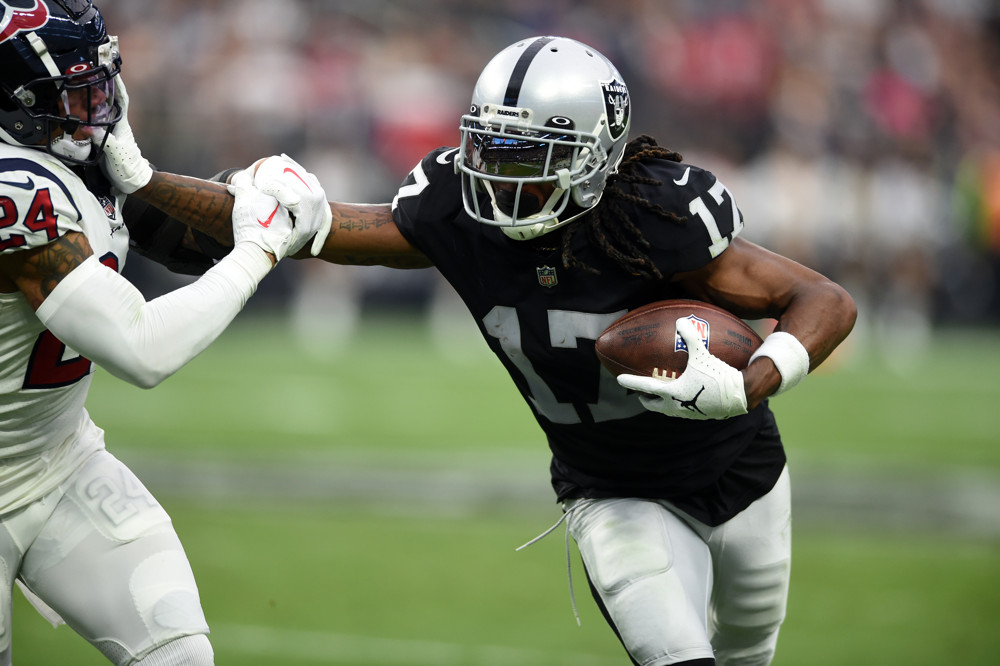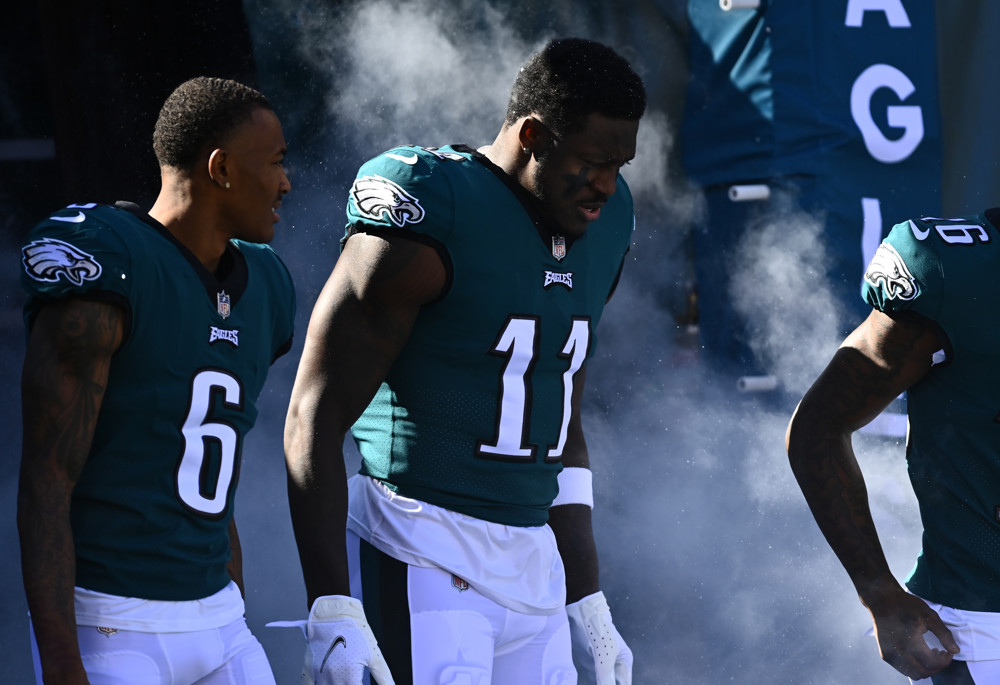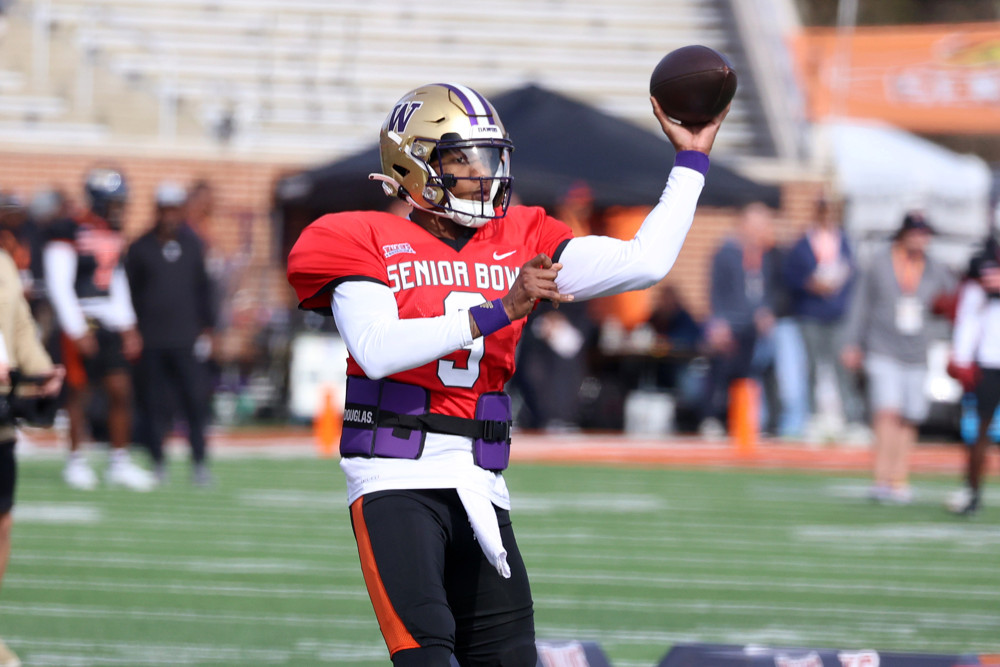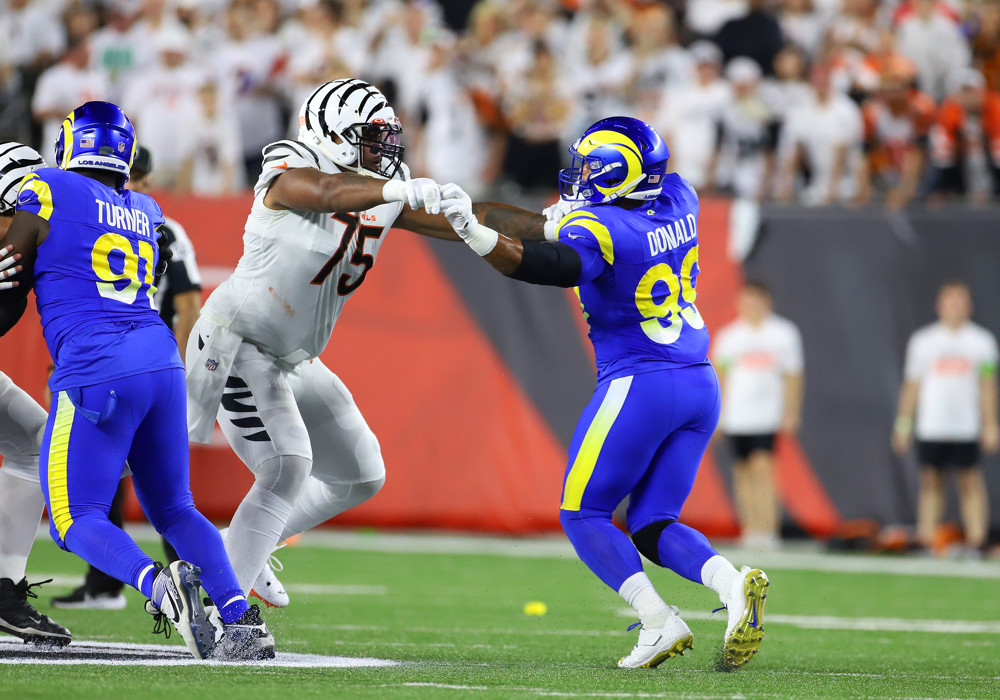
You may remember that back in the preseason, I introduced a new concept called Route DVOA. I’ve been doing receiving DVOA for 20 years, but it’s always been based on value per target. Route DVOA is based on value per routes run, which accounts for the skill of getting open and earning targets. It’s probably a better measurement of receiver quality and it’s definitely more consistent and predictive from year to year.
We don’t yet have all our methods streamlined enough to update Route DVOA automatically after each week’s games, but I have been putting it together once I get the FTN Data charting of routes run. My plan was to share the numbers with all of you readers after every six weeks. But I found myself with some extra time this week, so we’ll share numbers now. Next week, we’ll look at Route DVOA for defenses vs. types of receivers instead.
There are a couple of differences between this Route DVOA and what I did in the preseason from past years. First of all, thanks to FTN Data, I have actual routes run! No need for estimates. Now I’m not counting when a receiver is in the game but, for example, blocks for a screen to a different receiver. This means we can also produce Route DVOA for tight ends and running backs, not just wide receivers. The second change is that the work I did in the preseason only looked at passes with intended receivers, which is what counts in regular receiving DVOA. This new version of Route DVOA also incorporates routes run on sacks, scrambles, and passes thrown away with no intended receiver.
We’re still not at the point where we can adjust the value per route for which personnel grouping is on offense, but I’m hoping to do that in the near future.
Wide Receivers Through Week 5, 2023
There’s a couple of ways to look at these stats. We’ve got Route DVOA, or value per route. We’ve got Route DYAR, or total value based on routes. The player ranks are closer than they are for normal receiving DVOA, but not exactly the same. We can also look at the difference between a player’s regular receiving DVOA and his Route DVOA. To do this, I use z-scores, because Route DVOA has a wider scale than regular receiving DVOA. Z-scores look at the difference in standard deviations over average for each metric
OK, let’s take a look at the numbers. It is probably no shock that Tyreek Hill is leading the league in both Route DVOA and Route DYAR. Hill led the league in these stats in 2022 and he’s probably having an even better season this year. Hill stands out because he just doesn’t run as many routes as other No. 1 wide receivers. So his efficiency with the routes he does run is absurd. I have him down with 4.75 yards per route run, although this may differ from numbers you find elsewhere on FTN because of slight differences in counting routes (and because I add in DPI yardage, although Hill doesn’t have any of that yet). The only other receiver over 3.25 yards per route run is Brandon Aiyuk at 4.20.
The surprising name in here is Rashee Rice, the rookie receiver in Kansas City. He barely makes my minimum to be ranked, with 24 targets and only 65 routes, but he’s been targeted on a higher percentage of routes than any other wide receiver in the league. (These numbers do not include last night’s game against Denver.) Rice is third in Route DVOA and 18th in Route DYAR, which is really high despite the lack of usage. The Chiefs absolutely need to use him more and, in fact, started using him more last night, as he had four catches for 72 yards.
My minimum to be ranked here is 100 routes or 20 targets. First, here’s a look at the top wide receivers.
| Player | Team | Route DVOA |
Rank | Route DYAR |
Rank | Routes | Tgt Rate |
Yd/RR |
| Tyreek Hill | MIA | 148.8% | 1 | 404 | 1 | 137 | 36% | 4.75 |
| Brandon Aiyuk | SF | 131.1% | 2 | 234 | 9 | 90 | 30% | 4.20 |
| Rashee Rice | KC | 101.9% | 3 | 132 | 18 | 65 | 37% | 2.66 |
| Stefon Diggs | BUF | 89.0% | 4 | 324 | 2 | 180 | 29% | 3.27 |
| Davante Adams | LV | 87.6% | 5 | 313 | 4 | 175 | 32% | 2.67 |
| Keenan Allen | LAC | 77.4% | 6 | 240 | 8 | 149 | 30% | 3.00 |
| A.J. Brown | PHI | 74.0% | 7 | 279 | 6 | 180 | 29% | 3.11 |
| Mike Evans | TB | 71.8% | 8 | 164 | 14 | 106 | 30% | 3.25 |
| Ja’Marr Chase | CIN | 68.1% | 9 | 315 | 3 | 214 | 29% | 2.39 |
| Justin Jefferson | MIN | 66.3% | 10 | 285 | 5 | 200 | 27% | 2.91 |
| Nico Collins | HOU | 66.2% | 11 | 215 | 11 | 153 | 24% | 3.05 |
| DeAndre Hopkins | TEN | 59.2% | 12 | 172 | 13 | 137 | 31% | 2.60 |
It’s also worth noting rookie Puka Nacua of the Rams, who ranks seventh in Route DYAR and 14th in Route DVOA.
Here are the bottom qualifying wide receivers.
| Player | Team | Route DVOA |
Rank | Route DYAR |
Rank | Routes | Tgt Rate |
Yd/RR |
| Darnell Mooney | CHI | -57.7% | 86 | -107 | 83 | 135 | 12% | 0.77 |
| Donovan Peoples-Jones | CLE | -57.5% | 85 | -104 | 82 | 135 | 10% | 0.56 |
| Van Jefferson | LAR | -56.9% | 84 | -125 | 86 | 159 | 9% | 0.68 |
| Jalin Hyatt | NYG | -56.6% | 83 | -77 | 78 | 101 | 5% | 0.98 |
| Rondale Moore | ARI | -56.1% | 82 | -98 | 80 | 128 | 13% | 0.63 |
| Jaxon Smith-Njigba | SEA | -53.7% | 81 | -65 | 75 | 94 | 21% | 0.66 |
| Alec Pierce | IND | -48.1% | 80 | -109 | 84 | 176 | 10% | 0.80 |
| Jahan Dotson | WAS | -45.7% | 79 | -118 | 85 | 200 | 15% | 0.70 |
| Parris Campbell | NYG | -45.2% | 78 | -62 | 74 | 111 | 21% | 0.77 |
| Brandin Cooks | DAL | -43.5% | 77 | -59 | 71 | 105 | 19% | 1.05 |
Jalin Hyatt has five targets this year. FIVE! Maybe the Giants should consider trying to throw to him a little bit more?
Here are some players who do better in Route DVOA than regular DVOA. The first one is a particular surprise.
- JuJu Smith-Schuster, NE: -56.0% receiving DVOA to -28.9% Route DVOA.
- Jakobi Meyers, LV: -1.2% receiving DVOA to 36.6% Route DVOA.
- Robert Woods, HOU: -27.2% receiving DVOA to -3.0% Route DVOA.
- Garrett Wilson, NYJ: -21.2% receiving DVOA to 5.6% Route DVOA.
And some players who really decline when we use Route DVOA:
- Brandon Johnson, DEN: 63.7% receiving DVOA to -9.8% Route DVOA.
- Michael Wilson, ARI: 63.5% receiving DVOA to 12.1% Route DVOA.
- Gabe Davis, BUF: 58.9% receiving DVOA to 17.2% Route DVOA.
- Allen Lazard, NYJ: 35.6% receiving DVOA to -7.7% Route DVOA.
Tight Ends Through Week 5, 2023
For both running backs and tight ends, I’m using a minimum of 50 routes or 10 targets to be ranked. Here are the top tight ends:
| Player | Team | Route DVOA |
Rank | Route DYAR |
Rank | Routes | Tgt Rate |
Yd/RR |
| Andrew Ogletree | IND | 126.1% | 1 | 65 | 10 | 33 | 30% | 2.88 |
| Travis Kelce | KC | 95.5% | 2 | 161 | 1 | 104 | 36% | 2.13 |
| Sam LaPorta | DET | 67.3% | 3 | 140 | 2 | 128 | 24% | 2.26 |
| Noah Fant | SEA | 54.0% | 4 | 55 | 12 | 61 | 18% | 2.62 |
| Cole Kmet | CHI | 43.7% | 5 | 97 | 4 | 129 | 23% | 1.87 |
| Mark Andrews | BAL | 43.3% | 6 | 99 | 3 | 131 | 21% | 1.72 |
| George Kittle | SF | 43.1% | 7 | 89 | 5 | 119 | 19% | 1.81 |
| Jonnu Smith | ATL | 39.5% | 8 | 77 | 7 | 114 | 24% | 2.16 |
| Donald Parham | LAC | 37.4% | 9 | 41 | 15 | 57 | 16% | 0.65 |
| Jake Ferguson | DAL | 36.2% | 10 | 72 | 8 | 107 | 26% | 1.64 |
| Tre McBride | ARI | 32.7% | 11 | 29 | 19 | 46 | 22% | 1.72 |
| Darren Waller | NYG | 23.4% | 12 | 80 | 6 | 179 | 20% | 1.46 |
Smith and Ferguson, in particular, get a jump from regular receiving DVOA to Route DVOA. Now here are the tight ends on the bottom:
| Player | Team | Route DVOA |
Rank | Route DYAR |
Rank | Routes | Tgt Rate |
Yd/RR |
| Austin Hooper | LV | -66.0% | 48 | -85 | 48 | 94 | 7% | 0.66 |
| Taysom Hill | NO | -59.2% | 47 | -40 | 44 | 52 | 12% | 0.31 |
| Irv Smith | CIN | -45.9% | 46 | -54 | 45 | 89 | 11% | 0.43 |
| Michael Mayer | LV | -40.1% | 45 | -34 | 42 | 70 | 7% | 0.59 |
| Daniel Bellinger | NYG | -39.1% | 44 | -24 | 39 | 53 | 8% | 0.42 |
| Juwan Johnson | NO | -37.7% | 43 | -37 | 43 | 81 | 15% | 0.75 |
| Adam Trautman | DEN | -37.6% | 42 | -64 | 47 | 140 | 10% | 0.43 |
| Dawson Knox | BUF | -37.0% | 41 | -57 | 46 | 127 | 14% | 0.59 |
| Pat Freiermuth | PIT | -26.9% | 40 | -28 | 41 | 95 | 14% | 0.56 |
| David Njoku | CLE | -20.4% | 39 | -23 | 38 | 121 | 15% | 1.14 |
Maybe the Raiders want to try throwing to the tight ends a little more? Assuming they can get open. I’m surprised to see Taysom Hill here, because he’s always had very good receiving stats by regular receiving DVOA. (He doesn’t this year, though, with just 16 yards on six targets.)
Kelce, who ranks only 13th in regular receiving DVOA, is the big winner with Route DVOA. That makes a lot of sense, he earns a lot of targets. Cole Turner of Washington also takes a surprisingly big jump with Route DVOA, from -18.0% to 18.6%. Among the big falls with Route DVOA: C.J. Uzomah of the Jets goes from 30.1% to -19.9% and Durham Smythe of the Dolphins goes from 20.5% to -15.8%.
Running Backs Through Week 5, 2023
| Player | Team | Route DVOA |
Rank | Route DYAR |
Rank | Routes | Tgt Rate |
Yd/RR |
| De’Von Achane | MIA | 86.8% | 1 | 69 | 6 | 52 | 21% | 1.29 |
| Jaylen Warren | PIT | 85.0% | 2 | 92 | 3 | 76 | 33% | 2.18 |
| Christian McCaffrey | SF | 76.8% | 3 | 125 | 1 | 106 | 23% | 1.58 |
| Josh Jacobs | LV | 64.9% | 4 | 107 | 2 | 101 | 30% | 1.91 |
| Derrick Henry | TEN | 64.7% | 5 | 42 | 10 | 41 | 27% | 2.46 |
| Samaje Perine | DEN | 62.7% | 6 | 86 | 4 | 84 | 21% | 2.00 |
| Jerome Ford | CLE | 43.7% | 7 | 50 | 7 | 75 | 17% | 1.03 |
| Alvin Kamara | NO | 43.0% | 8 | 29 | 15 | 38 | 45% | 1.32 |
| Jahmyr Gibbs | DET | 38.3% | 9 | 40 | 12 | 61 | 30% | 1.15 |
| Jerick McKinnon | KC | 36.2% | 10 | 43 | 9 | 64 | 19% | 1.11 |
| Ameer Abdullah | LV | 35.7% | 11 | 20 | 20 | 35 | 29% | 1.31 |
| Bijan Robinson | ATL | 33.0% | 12 | 86 | 5 | 145 | 17% | 1.01 |
Alvin Kamara, in particular, has a huge difference between his regular receiving DVOA and his Route DVOA. He ranks 37 in receiving DVOA at -32.9%, but Route DVOA recognizes how often he earns a target on his routes. Gibbs also has a huge difference, going from -17.8% receiving DVOA to 38.3% Route DVOA.
Here are the running backs at the bottom:
| Player | Team | Route DVOA |
Rank | Route DYAR |
Rank | Routes | Tgt Rate |
Yd/RR |
| Ezekiel Elliott | NE | -42.8% | 50 | -23 | 45 | 64 | 23% | 0.69 |
| Najee Harris | PIT | -42.8% | 49 | -26 | 48 | 65 | 14% | 0.57 |
| Matt Breida | NYG | -42.8% | 48 | -32 | 50 | 86 | 12% | 0.57 |
| AJ Dillon | GB | -40.1% | 47 | -25 | 46 | 78 | 8% | 0.32 |
| Tyler Allgeier | ATL | -33.9% | 46 | -14 | 41 | 51 | 18% | 0.63 |
| Rachaad White | TB | -32.0% | 45 | -26 | 47 | 105 | 12% | 0.82 |
| Devin Singletary | HOU | -31.6% | 44 | -14 | 42 | 57 | 9% | 0.44 |
| Joe Mixon | CIN | -31.3% | 43 | -28 | 49 | 113 | 15% | 0.71 |
| Michael Carter | NYJ | -30.4% | 42 | -15 | 43 | 68 | 16% | 0.65 |
| Antonio Gibson | WAS | -27.9% | 41 | -22 | 44 | 119 | 13% | 1.11 |
The running back with the biggest drop from regular receiving DVOA to Route DVOA is San Francisco fullback Kyle Juszczyk. He has been targeted just five times on 62 routes, so he ends up going from 90.9% DVOA to 10.3% Route DVOA. Zack Moss of the Colts also takes a big drop from 27.9% receiving DVOA to -12.6% Route DVOA.
Next week, I’ll take a look at what it means to run DVOA by route for defenses against specific types of receivers, and how that differs from our usual receiving defense against types of receivers. And then we’ll update Route DVOA again after Week 12 to see how receivers are doing when we consider how often they get targeted per route.











































